
Here you can study for the exam. Look up keywords and learn definitions about all kind of subjects.
More subjects
The hammerhead sharks are a group of sharks that form the family Sphyrnidae, so named for the unusual and distinctive structure of their heads, which are flattened and laterally extended into a 'hammer' shape called a cephalofoil. Most hammerhead species are placed in the genus Sphyrna, while the winghead shark is placed in its own genus, Eusphyra. Many different, but not necessarily mutually exclusive, functions have been postulated for the cephalofoil, including sensory reception, manoeuvering, and prey manipulation. The cephalofoil gives the shark superior binocular vision and depth perception. Hammerheads are found worldwide in warmer waters along coastlines and continental shelves. Unlike most sharks, some hammerhead species usually swim in schools during the day, becoming solitary hunters at night. (Source: Wikipedia.org, CC BY-SA)
The hardhead catfish (Ariopsis felis) is a species of sea catfish from the northwest Atlantic and Gulf of Mexico, and similar to the gafftopsail catfish (Bagre marinus). It is one of four species in the genus Ariopsis. The common name, hardhead catfish, is derived from the presence of a hard, bony plate extending rearward toward the dorsal fin from a line between the catfish's eyes. It is an elongated marine catfish that reaches up to 28 in (70 cm) in length and 12 lb (5.5 kg) in weight. Their typical weight is less than 1 lb (450 g), but they commonly reach up to 3 lb (1.4 kg). They are often a dirty gray color on top, with white undersides. (Source: Wikipedia.org, CC BY-SA)
Herring are forage fish, mostly belonging to the family of Clupeidae. Herring often move in large schools around fishing banks and near the coast, found particularly in shallow, temperate waters of the North Pacific and North Atlantic Oceans, including the Baltic Sea, as well as off the west coast of South America. Three species of Clupea (the type genus of the herring family Clupeidae) are recognised, and provide about 90% of all herrings captured in fisheries. The most abundant of all is the Atlantic herring, providing over half of all herring capture. Fish called herring are also found in the Arabian Sea, Indian Ocean, and Bay of Bengal. (Source: Wikipedia.org, CC BY-SA)
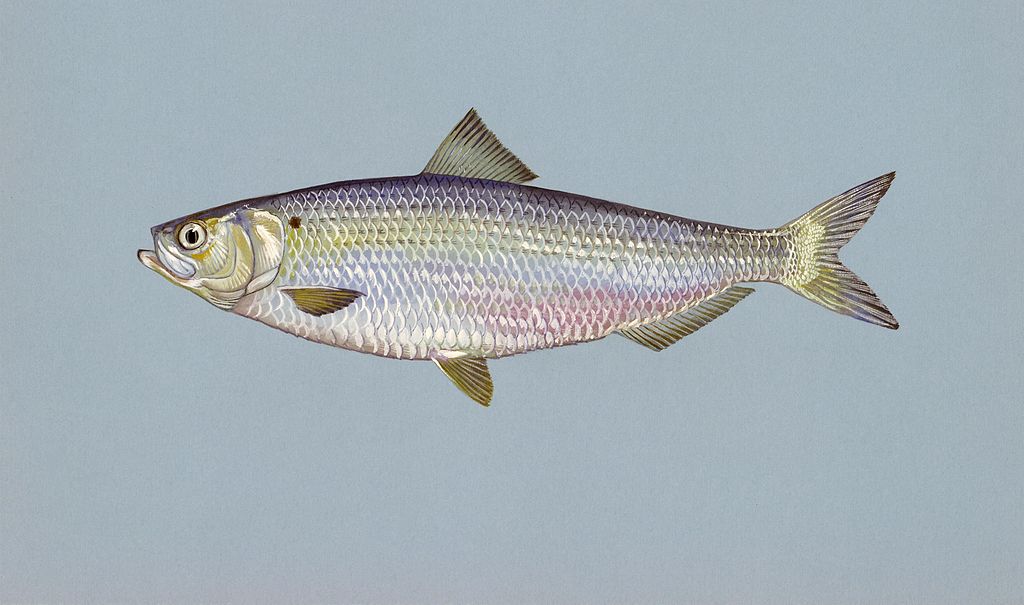 © Wikimedia.org/Duane Raver, CC0
© Wikimedia.org/Duane Raver, CC0
The horn shark (Heterodontus francisci) is a species of bullhead shark, in the family Heterodontidae. It is endemic to the coastal waters off the western coast of North America, from California to the Gulf of California. Young sharks are segregated spatially from the adults, with the former preferring deeper sandy flats and the latter preferring shallower rocky reefs or algal beds. A small species typically measuring 1 m (3.3 ft) in length, the horn shark can be recognized by a short, blunt head with ridges over its eyes, two high dorsal fins with large spines, and a brown or gray coloration with many small dark spots. (Source: Wikipedia.org, CC BY-SA)
The chum salmon (Oncorhynchus keta), also known as dog salmon or keta salmon, is a species of anadromous salmonid fish from the genus Oncorhynchus (Pacific salmon) native to the coastal rivers of the North Pacific and the Beringian Arctic, and is often marketed under the trade name silverbrite salmon in North America. The English name 'chum salmon' comes from the Chinook Jargon term tzum, meaning 'spotted' or 'marked'; while keta in the scientific name comes from Russian, which in turn comes from the Evenki language of Eastern Siberia. (Source: Wikipedia.org, CC BY-SA)
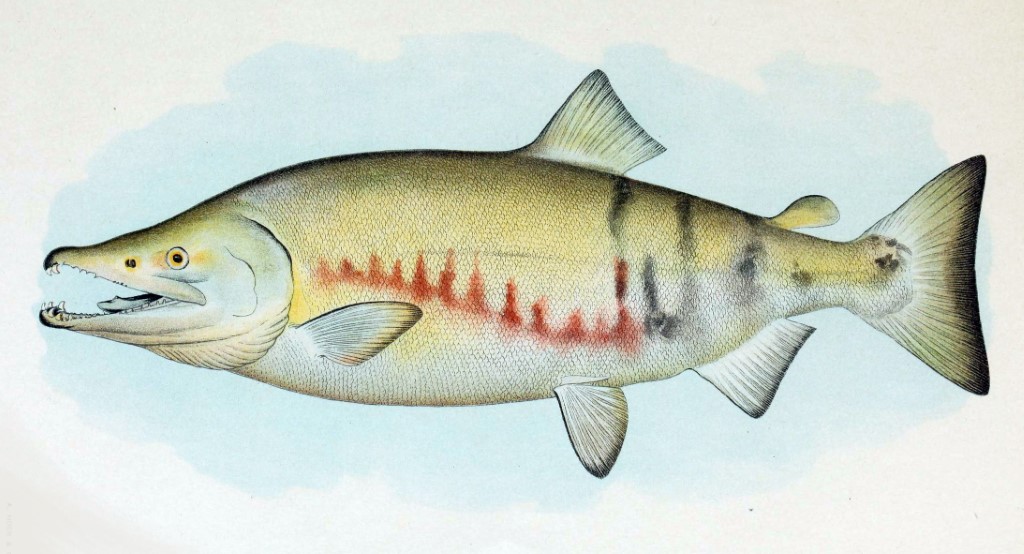 © Wikimedia.org/A. Hoen and Co., CC0
© Wikimedia.org/A. Hoen and Co., CC0
The kitefin shark or seal shark (Dalatias licha) is a species of squaliform shark in the family Dalatiidae, and the type species in its genus. It is found sporadically around the world, usually close to the sea floor at depths of 200–600 m (660–1,970 ft). With a sizable oil-filled liver to maintain neutral buoyancy, this shark is able to cruise slowly through the water while expending little energy. The kitefin shark, the largest luminous vertebrate on record, has a slender body with a very short, blunt snout, large eyes, and thick lips. Its teeth are highly differentiated between the upper and lower jaws, with the upper teeth small and narrow and the lower teeth large, triangular, and serrated. Its typical length is 1.0–1.4 m (3.3–4.6 ft), though examples as long as 5.9 ft (180 cm) have been encountered. (Source: Wikipedia.org, CC BY-SA)
Koi (鯉, English: /ˈkɔɪ/, Japanese: [koꜜi]) or more specifically nishikigoi (錦鯉, Japanese: [ɲiɕi̥kiꜜɡoi], literally 'brocaded carp'), are colored varieties of the Amur carp (Cyprinus rubrofuscus) that are kept for decorative purposes in outdoor koi ponds or water gardens. Koi is an informal name for the colored variants of C. rubrofuscus kept for ornamental purposes. There are many varieties of ornamental koi, originating from breeding that began in Niigata, Japan in the early 19th century. Several varieties are recognized by the Japanese, distinguished by coloration, patterning, and scalation. Some of the major colors are white, black, red, orange, yellow, blue, brown and cream, besides metallic shades like gold and silver-white ('platinum') scales. The most popular category of koi is the Gosanke, which is made up of the Kōhaku, Taishō Sanshoku and Shōwa Sanshoku varieties. (Source: Wikipedia.org, CC BY-SA)
Krill are small crustaceans of the order Euphausiacea, and are found in all the world's oceans. The name 'krill' comes from the Norwegian word krill, meaning 'small fry of fish', which is also often attributed to species of fish. Krill are considered an important trophic level connection – near the bottom of the food chain. They feed on phytoplankton and (to a lesser extent) zooplankton, yet also are the main source of food for many larger animals. In the Southern Ocean, one species, the Antarctic krill, Euphausia superba, makes up an estimated biomass of around 379,000,000 tonnes, making it among the species with the largest total biomass. Over half of this biomass is eaten by whales, seals, penguins, seabirds, squid, and fish each year. Most krill species display large daily vertical migrations, thus providing food for predators near the surface at night and in deeper waters during the day. (Source: Wikipedia.org, CC BY-SA)
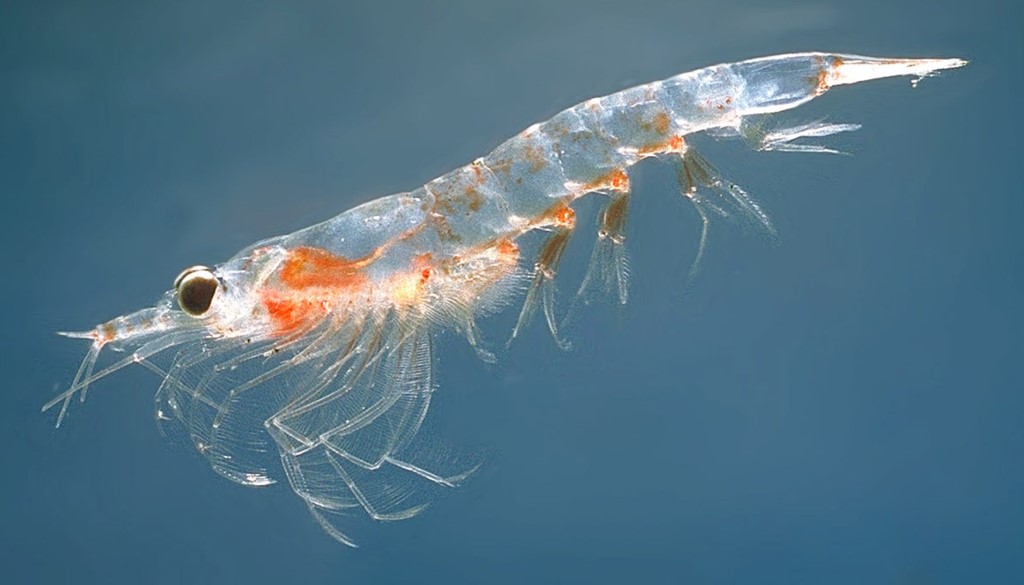 © Wikimedia.org/Øystein Paulsen, CC BY-SA
© Wikimedia.org/Øystein Paulsen, CC BY-SA
The lake sturgeon (Acipenser fulvescens), also known as the rock sturgeon, is a North American temperate freshwater fish, one of about 25 species of sturgeon. Like other sturgeons, this species is a bottom feeder with evolutionarily basal traits among fish, reflecting its early divergence from the shark lineage. These traits include a partly cartilaginous skeleton, an overall streamlined shape, and skin bearing rows of bony plates on the sides and back. The lake sturgeon uses its elongated, spade-like snout to stir up the substrate and sediments on the beds of rivers and lakes to feed. Four sensory organs (barbels) hang near its mouth to help the sturgeon locate bottom-dwelling prey. Lake sturgeons can grow to a large size for freshwater fish, topping 7.25 ft (2.2 m) long and 240 lb (108 kg). (Source: Wikipedia.org, CC BY-SA)
 © Wikimedia.org/Motokoka, CC BY-SA
© Wikimedia.org/Motokoka, CC BY-SA
Lampreys /ˈlæmpreɪz/ (sometimes inaccurately called lamprey eels) are an ancient extant lineage of jawless fish of the order Petromyzontiformes /ˌpɛtroʊmɪˈzɒntɪfɔːrmiːz/, placed in the superclass Cyclostomata. The adult lamprey may be characterized by a toothed, funnel-like sucking mouth. The common name 'lamprey' is probably derived from Latin lampetra, which may mean 'stone licker' (lambere 'to lick' + petra 'stone'), though the etymology is uncertain. Lamprey is sometimes seen for the plural form. (Source: Wikipedia.org, CC BY-SA)
Salarias fasciatus (jewelled blenny) is a popular marine aquarium fish species in Australasia. Despite being also known as the lawnmower blenny due to its propensity to consume algae growth from rocks and glass, it is principally a detritivore, with plant material making up only 15% of its diet. This species reaches a length of 14 centimetres (5.5 in) TL. The lawnmower blenny is generally regarded as compatible with most other marine fish species and as a group with other lawnmower blennies. The lawnmower blenny blends in with its surroundings, changing color to hide itself from predators. It stays mostly on the ocean or aquarium floor or on any rock or corals. (Source: Wikipedia.org, CC BY-SA)
The leafy seadragon (Phycodurus eques) or Glauert's seadragon, is the only member of the genus Phycodurus and is a marine fish in the family Syngnathidae, which includes seadragons, pipefish, and seahorses. It is found along the southern and western coasts of Australia. The name is derived from the appearance, with long leaf-like protrusions coming from all over the body. These protrusions are not used for propulsion; they serve only as camouflage. The leafy seadragon propels itself by means of a pectoral fin on the ridge of its neck and a dorsal fin on its back closer to the tail end. These small fins are almost completely transparent and difficult to see as they undulate minutely to move the creature sedately through the water, completing the illusion of floating seaweed. Popularly known as 'leafies', it is the marine emblem of the state of South Australia and a focus for local marine conservation. (Source: Wikipedia.org, CC BY-SA)
The leopard shark (Triakis semifasciata) is a species of houndshark, in the family Triakidae. It is found along the Pacific coast of North America, from the U.S. state of Oregon to Mazatlán in Mexico. Typically measuring 1.2–1.5 m (3.9–4.9 ft) long, this slender-bodied shark is immediately identifiable by the striking pattern of black saddle-like markings and large spots over its back, from which it derives its common name. Large schools of leopard sharks are a common sight in bays and estuaries, swimming over sandy or muddy flats or rock-strewn areas near kelp beds and reefs. They are most common near the coast, in water less than 4 m (13 ft) deep. (Source: Wikipedia.org, CC BY-SA)
Pterois is a genus of venomous marine fish, commonly known as lionfish, native to the Indo-Pacific. Also called firefish, turkeyfish, tastyfish, or butterfly-cod, it is characterized by conspicuous warning coloration with red, white, creamy, or black bands, showy pectoral fins, and venomous, spiky fin rays. Pterois radiata, Pterois volitans, and Pterois miles are the most commonly studied species in the genus. Pterois species are popular aquarium fish. P. volitans and P. miles are recent and significant invasive species in the west Atlantic, Caribbean Sea and Mediterranean Sea. (Source: Wikipedia.org, CC BY-SA)
The Synodontidae or lizardfishes are benthic (bottom-dwelling) marine and estuarine bony fishes that belong to the aulopiform fish order, a diverse group of marine ray-finned fish consisting of some 15 extant and several prehistoric families. They are found in tropical and subtropical marine waters throughout the world. Lizardfishes are generally small, although the largest species measures about 60 cm (24 in) in length. They have slender, somewhat cylindrical bodies, and heads that superficially resemble those of lizards. The dorsal fin is located in the middle of the back, and accompanied by a small adipose fin placed closer to the tail. They have mouths full of sharp teeth, even on the tongue. (Source: Wikipedia.org, CC BY-SA)
Loaches are fish of the superfamily Cobitoidea. They are freshwater, benthic (bottom-dwelling) fish found in rivers and creeks throughout Eurasia and northern Africa. Loaches are among the most diverse groups of fish; the 1249 known species of Cobitoidea comprise about 107 genera divided among 9 families. Loaches display a wide variety of morphologies, making the group difficult to characterize as a whole using external traits. They range in adult length from the 23 mm (1 in) miniature eel-loach, Pangio longimanus, to the 50 cm (20 in) imperial flower loach, Leptobotia elongata, with the latter weighing up to 3 kg (6.6 lbs). Most loaches are small, narrow-bodied and elongate, with minute cycloid scales that are often embedded under the skin, patterns of brown-to-black pigment along the dorsal surface and sides, and three or more pairs of whisker-like barbels at the mouth. The type species of the family Cobitidae, Cobitis taenia, has a body shape and pigment pattern typical of Cobitoidea. However, many loaches are eel-like or conversely, quite stout-bodied; some balitorids have large, visible scales. (Source: Wikipedia.org, CC BY-SA)
 © Wikimedia.org/TropicalAquaticsRSA, CC BY-SA
© Wikimedia.org/TropicalAquaticsRSA, CC BY-SA
The longnose gar (Lepisosteus osseus), also known as longnose garpike or billy gar, is a ray-finned fish in the family Lepisosteidae. The genus may have been present in North America for about 100 million years. References are made to gars being a primitive group of bony fish because they have retained some primitive features, such as a spiral valve intestine, but they are not primitive in the sense of not being fully developed. They have an olive brown to green, torpedo-shaped body armored with ganoid scales, elongated jaws that form a needle-like snout nearly three times the length of its head, and a row of numerous sharp, cone-shaped teeth on each side of the upper jaw. They typically inhabit freshwater lakes, brackish water near coastal areas, swamps, and sluggish backwaters of rivers and streams. They can breathe both air and water, which allows them to inhabit aquatic environments that are low in oxygen. (Source: Wikipedia.org, CC BY-SA)
The Cyclopteridae are a family of marine fishes, commonly known as lumpsuckers or lumpfish, in the order Scorpaeniformes. They are found in the cold waters of the Arctic, North Atlantic, and North Pacific oceans. The greatest number of species are found in the North Pacific. The family name Cyclopteridae derives from the Greek words κύκλος (kyklos), meaning 'circle', and πτέρυξ (pteryx), meaning 'wing' or 'fin', in reference to the circle-shaped pectoral fins of most of the fish in this family. Lumpsuckers are named appropriately enough; their portly bodies are nearly spherical with generally drab coloration and lithic patterns. The 'sucker' part refers to the fish's modified pelvic fins, which have evolved into adhesive discs (located ventrally, behind the pectoral fins); the fish use these discs to adhere to the substrate. Many species have bony, wart-like tubercles adorning the head and body; these are important taxonomic features of the family. (Source: Wikipedia.org, CC BY-SA)
Lungfish are freshwater vertebrates belonging to the order Dipnoi. Lungfish are best known for retaining ancestral characteristics within the Osteichthyes, including the ability to breathe air, and ancestral structures within Sarcopterygii, including the presence of lobed fins with a well-developed internal skeleton. Lungfish represent the closest living relatives of the tetrapods. Today there are only six known species of lungfish, living in Africa, South America, and Australia. The fossil record shows that lungfish were abundant since the Triassic. While vicariance would suggest this represents an ancient distribution limited to the Mesozoic supercontinent Gondwana, the fossil record suggests advanced lungfish had a widespread freshwater distribution and the current distribution of modern lungfish species reflects extinction of many lineages subsequent to the breakup of Pangaea, Gondwana and Laurasia. Lungfish have historically been referred to as salamanderfish, but this term more often refers to Lepidogalaxias salamandroides. (Source: Wikipedia.org, CC BY-SA)
Manta rays are large rays belonging to the genus Mobula (formerly its own genus Manta). The larger species, M. birostris, reaches 7 m (23 ft) in width, while the smaller, M. alfredi, reaches 5.5 m (18 ft). Both have triangular pectoral fins, horn-shaped cephalic fins and large, forward-facing mouths. They are classified among the Myliobatiformes (stingrays and relatives) and are placed in the family Myliobatidae (eagle rays). They have the largest brains and brain to body ratio of all fish, and can pass the mirror test. (Source: Wikipedia.org, CC BY-SA)
 © Wikimedia.org/Shiyam ElkCloner, CC BY-SA
© Wikimedia.org/Shiyam ElkCloner, CC BY-SA
Genicanthus personatus the masked angelfish, is a species of marine ray-finned fish, a marine angelfish belonging to the family Pomacanthidae. It is endemic to Hawaii. Genicanthus personatus is largely a brilliant white colour at all ages. The juveniles have an area of black colour which covers most of the head. As the fish grows this breaks up starting with the lips which turn bluish white and their caudal fins begin to darken to become black. This species, like all marine angelfish, is a sequential protogynous hermaphrodite and the younger sexually mature adults are all females. The black on the head reduces in extent. The black eventually only surrounds the eyes, is on the chin and along the edge of the operculum and its operculum spine. They also have yellow pelvic fins. Once they reach a length of 15 to 18 centimetres (5.9 to 7.1 in) they may change sex to males. When they do so, they develop a vivid orange yellow pigmentation on the pectoral fins and on the whole face as well as on the margins of its dorsal, anal and pelvic fins. The males develop long filamentous extensions to the caudal fin lobes. This species attains a maximum total length of 21 centimetres (8.3 in). (Source: Wikipedia.org, CC BY-SA)
The Mekong giant catfish (Pangasianodon gigas; Thai: ปลาบึก, RTGS: pla buek, pronounced [plāː bɯ̀k]; Khmer: ត្រីរាជ /trəy riec/; Vietnamese: cá tra dầu), is a large, threatened species of catfish (order Siluriformes) in the shark catfish family (Pangasiidae), native to the Mekong basin in Southeast Asia and adjacent China. It is considered critically endangered due to accelerating habitat loss. Grey to white in color and lacking stripes, the Mekong giant catfish is distinguished from other large catfish species in the river by the near-total lack of barbels and the absence of teeth. Young Mekong catfish do exhibit barbels and oral teeth, but these features diminish as they age and are absent by the time they grow to be 30-50cm in length. (Source: Wikipedia.org, CC BY-SA)
The milkfish (Chanos chanos) is the sole living species in the family Chanidae. However, there are at least five extinct genera from the Cretaceous. The repeating scientific name (tautonym) is from Greek khanos (χάνος ‘mouth’). The species has many common names. The Hawaiian name for the fish is awa, and in Tahitian it is ava. It is called bangús in the Philippines, where it is popularly known as the national fish, although the National Commission for Culture and the Arts has stated that this is not the case as it has no basis in Philippine law. In the Nauruan language, it is referred to as ibiya. Milkfish is also called bandeng or bolu in Indonesia. (Source: Wikipedia.org, CC BY-SA)
The mojarras are a family, Gerreidae, of fish in the order Perciformes. The family includes about 53 species found worldwide in tropical and warm temperate regions. They mostly inhabit coastal salt and brackish waters, although some occur in fresh water. Mojarras are a common prey and bait fish in many parts of the world, including the South American coast and Caribbean islands as well as the Gulf of Mexico and the Atlantic coast of North America. These species tend to be difficult to identify in the field and often require microscopic examination. Most species exhibit a schooling behavior and tend to exploit the shallow water refugia associated with coastal areas presumably to avoid large-bodied predators, such as the lemon shark. (Source: Wikipedia.org, CC BY-SA)
Members of the genus Lophius, also sometimes called monkfish, fishing-frogs, frog-fish, and sea-devils, are various species of lophiid anglerfishes found in the Atlantic and Indian Oceans. Lophius is known as the 'monk' or 'monkfish' to the North Sea and North Atlantic fishermen, a name which also belongs to Squatina squatina, the angelshark, a type of shark. The North European species is Lophius piscatorius, and the Mediterranean species is Lophius budegassa. (Source: Wikipedia.org, CC BY-SA)
Moray eels, or Muraenidae (/ˈmɒreɪ, məˈreɪ/), are a family of eels whose members are found worldwide. There are approximately 200 species in 15 genera which are almost exclusively marine, but several species are regularly seen in brackish water, and a few are found in fresh water. The English name, from the early 17th century, derives from Portuguese moréia, which itself derives from Latin mūrēna, in turn from Greek μύραινα, muraina; these are the Latin and Greek names of the Mediterranean moray. Morays are opportunistic, carnivorous predators and feed primarily on smaller fish, crabs, and octopuses. A spotted moray eel has been observed eating a red lionfish without harm. Groupers, barracudas and sea snakes are among their few known predators, making many morays (especially the larger species) apex predators in their ecosystems. (Source: Wikipedia.org, CC BY-SA)
Needlefish (family Belonidae) or long toms are piscivorous fishes primarily associated with very shallow marine habitats or the surface of the open sea. Some genera include species found in marine, brackish, and freshwater environments (e.g., Strongylura), while a few genera are confined to freshwater rivers and streams, including Belonion, Potamorrhaphis, and Xenentodon. Needlefish closely resemble North American freshwater gars (family Lepisosteidae) in being elongated and having long, narrow jaws filled with sharp teeth, and some species of needlefishes are referred to as gars or garfish despite being only distantly related to the true gars. In fact, the name 'garfish' was originally used for the needlefish Belone belone in Europe and only later applied to the North American fishes by European settlers during the 18th century. (Source: Wikipedia.org, CC BY-SA)
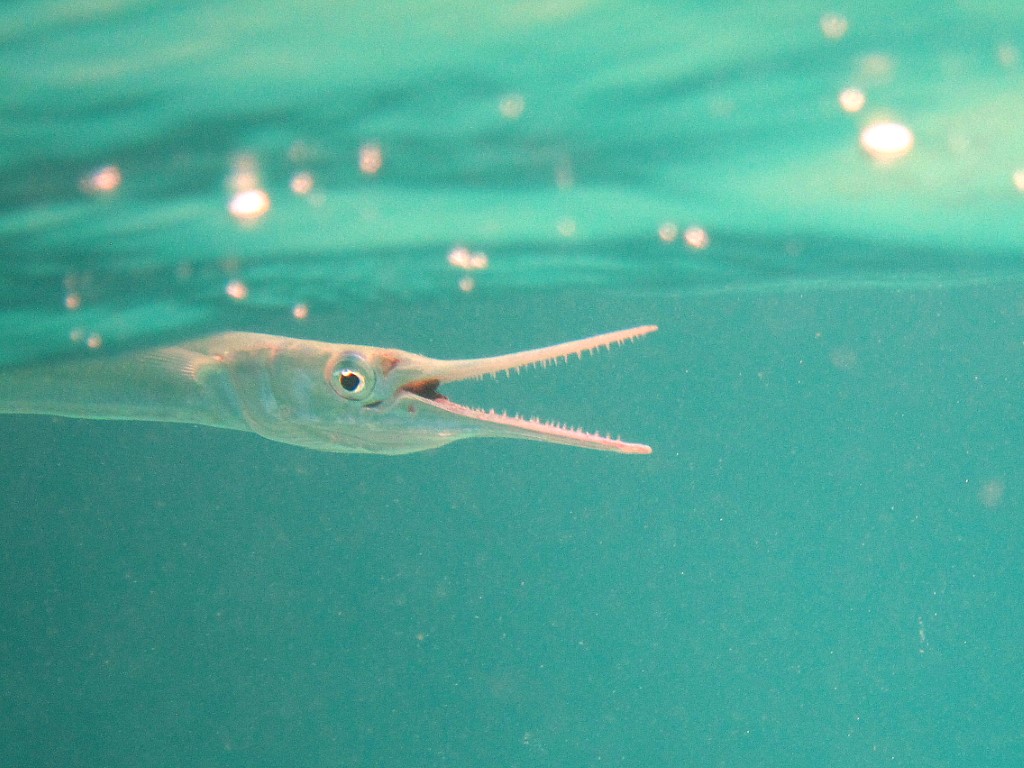 © Wikimedia.org/Christian Grill, CC BY-SA
© Wikimedia.org/Christian Grill, CC BY-SA
Cephalopholis igarashiensis, known as the garish hind, Neptune grouper, goldbar grouper, or Japanese cod, is a deepwater species of marine ray-finned fish, a grouper from the subfamily Epinephelinae which is in the family Serranidae which also includes the anthias and sea basses. It is found on coral reefs at depths of 80 to 250 m (260 to 820 ft) in the Indo-Pacific. Cephalopholis igarashiensis has a deep body with the depth of the body being greater than the length of the head, the standard length is 2.0 to 2.4 times the depth of the body. The dorsal profile of the head is straight or marginally concave to beyond the eye while the nape is distinctly convex. The preopercleis rounded and the edges have fine serrations although those on the ventral margin are slightly less fine giving it a more irregular appearance but the serration remain enclosed within the skin. The dorsal fin contains 9 spines and 14 soft rays while the anal fin has 3 spines and 9 soft rays. (Source: Wikipedia.org, CC BY-SA)
The nurse shark (Ginglymostoma cirratum) is an elasmobranch fish in the family Ginglymostomatidae. The conservation status of the nurse shark is globally assessed as Vulnerable in the IUCN List of Threatened Species. They are considered to be a species of least concern in the United States and in The Bahamas, but considered to be near threatened in the western Atlantic Ocean because of their vulnerable status in South America and reported threats throughout many areas of Central America and the Caribbean. They are directly targeted in some fisheries and considered by-catch in others. Nurse sharks are an important species for shark research. They are robust and able to tolerate capture, handling, and tagging extremely well. As inoffensive as nurse sharks may appear, they are ranked fourth in documented shark bites on humans, likely due to incautious behavior by divers on account of the nurse shark's slow, sedentary nature. (Source: Wikipedia.org, CC BY-SA)
The ocean sunfish or common mola (Mola mola) is one of the largest bony fish in the world. It was misidentified as the heaviest bony fish which was actually a different species the Mola alexandrini. Adults typically weigh between 247 and 1,000 kg (545 and 2,205 lb). The species is native to tropical and temperate waters around the world. It resembles a fish head without a tail, and its main body is flattened laterally. Sunfish can be as tall as they are long when their dorsal and ventral fins are extended. Sunfish are generalist predators that consume largely small fish, fish larvae, squid, and crustaceans. Sea jellies and salps, once thought to be the primary prey of sunfish, make up only 15% of a sunfish's diet. Females of the species can produce more eggs than any other known vertebrate, up to 300,000,000 at a time. Sunfish fry resemble miniature pufferfish, with large pectoral fins, a tail fin, and body spines uncharacteristic of adult sunfish. (Source: Wikipedia.org, CC BY-SA)
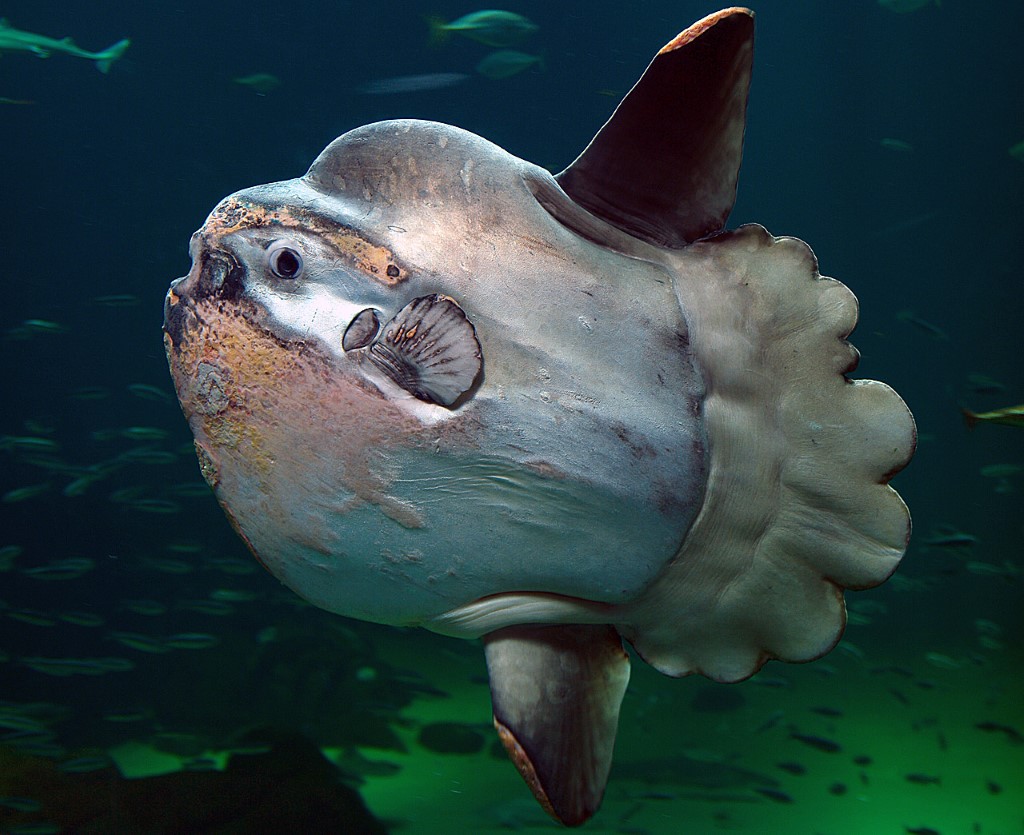 © Wikimedia.org/Per-Ola Norman, CC0
© Wikimedia.org/Per-Ola Norman, CC0
The oscar (Astronotus ocellatus) is a species of fish from the cichlid family known under a variety of common names, including tiger oscar, velvet cichlid, and marble cichlid. In tropical South America, where the species naturally resides, A. ocellatus specimens are often found for sale as a food fish in the local markets. The fish has been introduced to other areas, including India, China, Australia, and the United States. It is considered a popular aquarium fish in Europe and the U.S. (Source: Wikipedia.org, CC BY-SA)
The oyster toadfish, Opsanus tau, also known as the oyster toad, ugly toad, oyster cracker, oyster catcher, and bar dog, is a Northeast Atlantic species of fish of the family Batrachoididae. The maximum length of this toadfish is 43.2 cm (17 in), but they infrequently surpass 38 cm (15 in). The world record size for this species is 19.2 inches which is 48.76 cm. They are generally yellowish with a pattern of brown oblique bars. The species can live in poor conditions and needs little food to live. It is an omnivore. Common prey include crustaceans, mollusks, amphipods, squid, and other smaller fish. Oyster toadfish rely upon camouflage to catch their food; they lie motionless waiting for prey to pass close by, then attack by surprise. They can be found near the shore from Maine to Florida. (Source: Wikipedia.org, CC BY-SA)
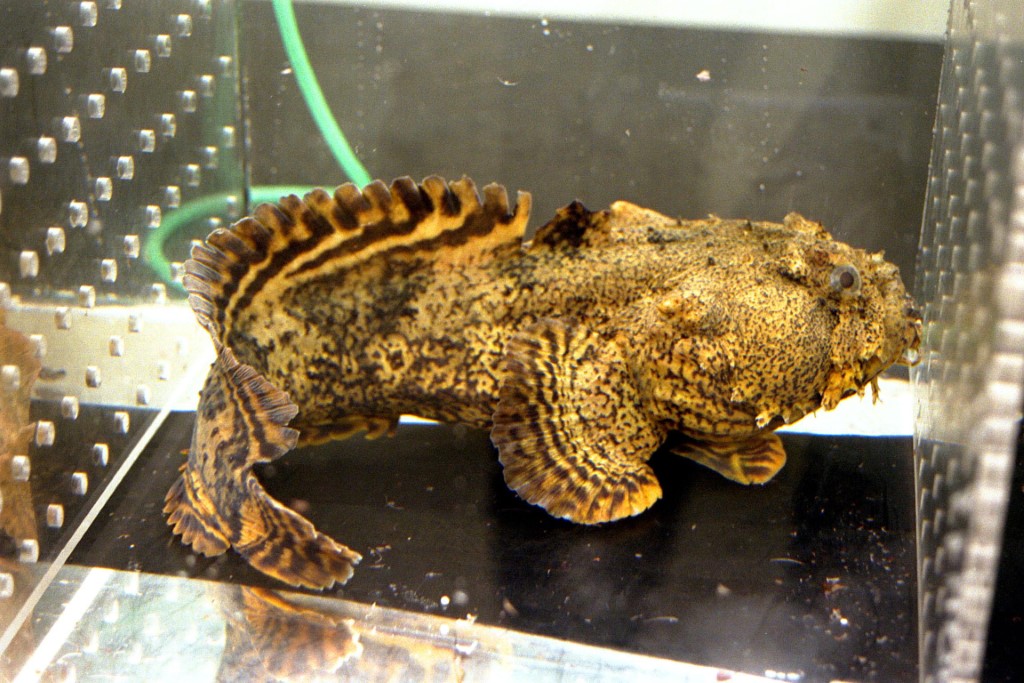 © Wikimedia.org, CC0
© Wikimedia.org, CC0
Paddlefish (family Polyodontidae) are a family of ray-finned fish belonging to order Acipenseriformes, and one of two living groups of the order alongside sturgeons (Acipenseridae). They are distinguished from other fish by their titular elonglated rostrums, which are thought to enhance electroreception to detect prey. Paddlefish have been referred to as 'primitive fish' because Acipenseriformes are amongst the earliest diverging lineages of ray-finned fish, having diverged from all other living groups over 300 million years ago. Paddlefish are almost exclusively North American and Chinese, both extant and in the fossil record. (Source: Wikipedia.org, CC BY-SA)
Parrotfishes are a group of about 90 fish species regarded as a family (Scaridae), or a subfamily (Scarinae) of the wrasses. With about 95 species, this group's largest species richness is in the Indo-Pacific. They are found in coral reefs, rocky coasts, and seagrass beds, and can play a significant role in bioerosion. Parrotfish are named for their dentition, which is distinct from other fish, including other labrids. Their numerous teeth are arranged in a tightly packed mosaic on the external surface of their jaw bones, forming a parrot-like beak with which they rasp algae from coral and other rocky substrates (which contributes to the process of bioerosion). (Source: Wikipedia.org, CC BY-SA)
The peppermint angelfish (Centropyge boylei) is a relatively small species of marine ray-finned fish, a marine angelfish belonging to the family Pomacanthidae. It is found in the Central area of the South Pacific Ocean, and is known to be native to the Cook Islands. The peppermint angelfish has a deep, oval shaped body which has five white vertical bands on a reddish-orange background. The dorsal and anal fins have white margins and the caudal fin is translucent. The face and chin are white. This species attains a maximum total length of 7 centimetres (2.8 in). (Source: Wikipedia.org, CC BY-SA)
Perch is a common name for fish of the genus Perca, freshwater gamefish belonging to the family Percidae. The perch, of which three species occur in different geographical areas, lend their name to a large order of vertebrates: the Perciformes, from the Greek: πέρκη (perke), simply meaning perch, and the Latin forma meaning shape. Many species of freshwater gamefish more or less resemble perch, but belong to different genera. In fact, the exclusively saltwater-dwelling red drum is often referred to as a red perch, though by definition perch are freshwater fish. Though many fish are referred to as perch as a common name, to be considered a true perch, the fish must be of the family Percidae. (Source: Wikipedia.org, CC BY-SA)
Esox is a genus of freshwater fish commonly known as pike or pickerel. It is the type genus of the family Esocidae. The type species of the genus is Esox lucius, the northern pike. Esox has been present in Laurentia (which later became North America) and Eurasia since the Paleocene. Modern large pike species are native to the Palearctic and Nearctic realms, ranging across Northern America and from Western Europe to Siberia in North Asia. Pikes have the elongated, torpedo-like shape typical of predatory fishes, with sharply pointed heads and sharp teeth. Their coloration is typically grey-green with a mottled or spotted appearance with stripes along their backs, providing camouflage among underwater weeds, and each individual pike marking patterns are unique like fingerprints. Pikes can grow to a maximum recorded length of 1.83 m (6 ft), reaching a maximum recorded weight of 35 kg (77 lb).[citation needed] (Source: Wikipedia.org, CC BY-SA)
Pipefishes or pipe-fishes (Syngnathinae) are a subfamily of small fishes, which, together with the seahorses and seadragons (Phycodurus and Phyllopteryx), form the family Syngnathidae. Pipefish look like straight-bodied seahorses with tiny mouths. The name is derived from the peculiar form of the snout, which is like a long tube, ending in a narrow and small mouth which opens upwards and is toothless. The body and tail are long, thin, and snake-like. They each have a highly modified skeleton formed into armored plating. This dermal skeleton has several longitudinal ridges, so a vertical section through the body looks angular, not round or oval as in the majority of other fishes. (Source: Wikipedia.org, CC BY-SA)
A piranha or piraña (/pɪˈrɑːnjə/, /pɪˈrænjə/, or /pɪˈrɑːnə/; Portuguese: [piˈɾɐ̃ɲɐ] or [piˈɾɐ̃j̃ɐ], Spanish: [piˈɾaɲa]), a member of family Serrasalmidae, or a member of the subfamily Serrasalminae within the tetra family, Characidae in order Characiformes. They are freshwater fish that inhabit South American rivers, floodplains, lakes and reservoirs. Although often described as extremely predatory and mainly feeding on fish, their dietary habits vary extensively, and they will also take plant material, leading to their classification as omnivorous. Piranhas have one of the strongest bites found in bony fishes. Relative to body mass, the black piranha (Serrasalmus rhombeus) produces one of the most forceful bites measured in vertebrates. This extremely powerful and dangerous bite is generated by large jaw muscles (adductor mandibulae) that are attached closely to the tip of the jaw, conferring the piranha with a mechanical advantage that favors force production over bite speed. Strong jaws combined with finely serrated teeth make them adept at tearing flesh. (Source: Wikipedia.org, CC BY-SA)
The porbeagle (Lamna nasus) is a species of mackerel shark in the family Lamnidae, distributed widely in the cold and temperate marine waters of the North Atlantic and Southern Hemisphere. In the North Pacific, its ecological equivalent is the closely related salmon shark (L. ditropis). It typically reaches 2.5 m (8.2 ft) in length and a weight of 135 kg (298 lb); North Atlantic sharks grow larger than Southern Hemisphere sharks and differ in coloration and aspects of life history. Gray above and white below, the porbeagle has a very stout midsection that tapers towards the long, pointed snout and the narrow base of the tail. It has large pectoral and first dorsal fins, tiny pelvic, second dorsal, and anal fins, and a crescent-shaped caudal fin. The most distinctive features of this species are its three-cusped teeth, the white blotch at the aft base of its first dorsal fin, and the two pairs of lateral keels on its tail. (Source: Wikipedia.org, CC BY-SA)
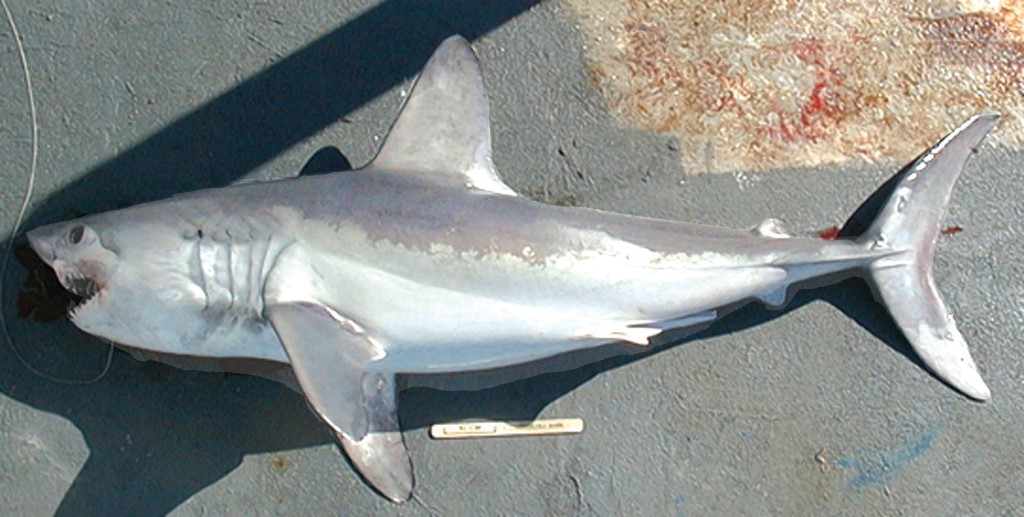 © Wikimedia.org/NOAA, CC0
© Wikimedia.org/NOAA, CC0

Time for recess! Post a comment, ask a question or write a review. Feel free to let us know what you think!
look at the sign on the road to avoid accidents and horrible driving conditions
I received a 300$ ticket because I passed a police control of other cars/drivers on the right lane of a highway (the control was on the hard shoulder of the highway). Is it really true, that you have to change the lane in such cases? Thanks!
I am an American living in Italy. The Italian Drivers License theory test is the hardest test I have ever studied for and I am in my 70s have multiple degrees, multiple professional certifications. Have to take the Italian Drivers Theory test in Italian. No english. So many rules. More signs in small medieval Italian town I live in then in major US cities I have lived in. No Italian license no driving. No buying or renting a car. Test here was good, clean. Lots of tricky questions on many practice and real official tests. Thanks
Most problems are a result of higher than safe driving speeds. Please just slow down and be patient.
Question 121: Poor translation: Vehicles with polluted fluids prohibited Should be translated as: Vehicles with dangerous liquids prohibited
Question 83: Poor translation: Vehicles with polluted fluids prohibited Should be translated as: Vehicles with dangerous liquids prohibited
Want even more practice? Visit similar websites offering realistic practice driving knowledge tests. Visit us to see what sets our tests apart! https://dkttest.com/capital-territory/
Cool tool! And fun to check whether I remember the rules :) Two things I noticed: Warning for a crossroad side roads on the left and right. While technically that might be the correct translation, this sign tells you, that you are on the main road and have the right of way for the next crossroad and only the next crossroad. Usually (if no sign specifies otherwise) you have to give way to drivers coming from the right at every intersection, which can get a bit annoying in communal areas, so seeing this sign feels less like a warning and more like relief :). A Fahrradstraße is not a lane for cyclists but a street for cyclists, meaning the (whole!) street is intended predominantly for cyclists, who are then allowed to ride next to each other. Cars are allowed to drive there (unless another sign prohibits such), but have to adjust their speed to the cyclists. I believe they are not allowed to pass at all, even if the oncoming lane is empty.
More community